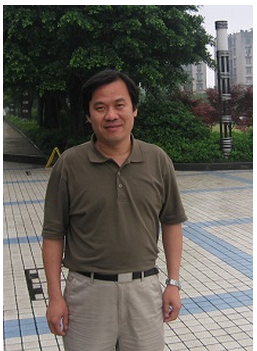首页> >文章内容
教学名师米据生
返回 2016-05-25

个人简介:
1966年3月生,男,汉族,河北省宁晋县人,理学博士。主要从事人工智能的数学基础方面的研究,在粗糙集理论及其应用、概念格理论、不确定性分析、粒计算等方面取得了一系列研究成果,发表学术论文80余篇,其中被SCI收录24篇,ESI高被引论文4篇。2003年以来多次应邀到香港中文大学进行合作研究。2005年至2006年,在香港中文大学地理与资源管理学系从事博士后研究工作。现任中国人工智能学会粗糙集与软计算专业委员会常务委员、河北省数学会副理事长、河北省机器学习学会副理事长、祖冲之研究会副会长。主持完成一项国家自然科学基金(NO:60773174,基于概念格的属性约简与知识获取方法研究),一项河北省自然科学基金(NO:A2006000129,概念格属性约简方法与知识获取)。现主持一项国家自然科学基金(NO:61170107,多源信息系统知识获取的粒计算方法),一项教育部博士点基金(NO:20101303110004,直觉模糊环境下基于粒计算的知识获取方法研究 )。研究成果“复杂信息系统知识发现的数学基础研究”于2012年获河北省自然科学二等奖。
详细介绍
教育背景:
博士,理学,西安交通大学,2000至2003
硕士,理学,华东师范大学,1989至1992
学士,理学,河北师范大学,1982至1986
工作经历:
合作研究:香港中文大学,2003年8月—2004年2月,2004年10月—12月,2006年10月—12月,2008年1月—3月,2011年3月
博士后:2005年—2006年,香港中文大学地理与资源管理学系
1998年—现在,河北师范大学数学系
1986年—1998年,河北师范学院数学系
教学情况:
主讲课程: 《数学分析》、《复变函数》、《实变函数》、《分析方法》
出版教材
[1] 杨林生,乔玉英,米据生,复变函数,高等教育出版社,2000.9.
[2] 米据生,副主编,经济应用数学,地质大学出版社, 1997.
[3] 米据生,副主编,经济数学(上、下),吉林大学出版社, 2000.
科研情况:
获奖
“复杂信息系统知识发现的数学基础研究”于2012年获河北省自然科学二等奖。
基金
1. 多源信息系统知识获取的粒计算方法,国家自然科学基金(61170107),主持,2012.1-2014.12。
2. 直觉模糊环境下基于粒计算的知识获取方法研究,高等学校博士学科点专项科研基金,主持,2011-2013。
3. 基于模糊形式背景的形式概念分析理论研究,国家自然科学基金(60963006),承担,2010.1-2012.12。
4. 基于概念格的属性约简与知识获取方法研究,国家自然科学基金(60773174),主持,2008.1-2010.12。
5. 概念格属性约简方法与知识获取,河北省自然科学基金(A2006000129),主持,2006.1-2008.12。
6. 不相交的三元系及其应用, 国家自然科学基金项目(10271039), 承担,2003.1-2005.12。
7. 模糊与随机环境下的粗糙集理论与知识获取, 国家自然科学基金项目(60373078), 承担,2004.1-2006.12。
主要期刊论文
[1] The strong direct product of formal contexts,Information Sciences, 226 (2013): 47–67.
[2] The reduction and fusion of fuzzy covering systems based on the evidence theory, International Journal of Approximate Reasoning, 53 (2012): 87–103.
[3] Measuring inclusion, similarity and compatibility between intuitionistic fuzzy sets, International Journal of Uncertainty, Fuzziness and Knowledge-Based Systems, 20(2)( 2012): 251-274.
[4] 无限论域中的粗糙近似空间与信任结构, 计算机研究与发展,49(2)(2012):327-336.
[5] Intuitionistic fuzzy rough sets and intuitionistic fuzzy topology spaces, Information-an International Interdisciplinary Journal, 14(8)( 2011): 2553-2562.
[6] Reductions of a Fuzzy Covering Decision System,International Journal of Modelling, Identification and Control, 13( 3)( 2011):225-233.
[7] Attribute reduction based on generalized fuzzy evidence theory in fuzzy decision systems, Fuzzy Sets and Systems, 170(2011):64–75
[8] Dependence-space-based attribute reduction in consistent decision tables, Soft Comput, 15(2011):261–268
[9] Some Mathematical Structures of Generalized Rough Sets in Infinite Universes of Discourse, Transactions on Rough Sets, XIII(2011): 175–206.
[10] The Construction of Fuzzy Concept Lattices Based on (θ, σ)-Fuzzy Rough Approximation Operators, Fundamenta Informaticae, 111(1)(2011): 33–45.
[11] Attribute reduction in decision formal context based on homomorphism,International Journal of Machine Learning and Cybernetics, 2(4)(2011):289-29.
[12] Approaches to attribute reduction in concept lattices induced by axialities Knowledge-Based Systems, 23(6)(2010): 504-511.
[13] Concept lattices determined by an inclusion degree, Information–an International Interdisciplinary Journal, 12(6)(2009): 1205-1216
[14] On Generalized Fuzzy Belief Functions in Infinite Spaces, IEEE Transactions on Fuzzy Systems, 17(2)(2009): 385-397.
[15] Granular Computing and Knowledge Reduction in Formal Context, IEEE Transactions on Knowledge and Data Engineering, 21(10)(2009): 1461-1474.
[16] Generalized fuzzy rough sets determined by a triangular norm,Information Sciences, 178(16)(2008): 3203-3213
[17] Existence of Solutions for Stochastic Volterra Integral Inclusion in Hilbert Spaces, Southeast Asian Bulletin of Mathematics, 32(2008): 71-77
[18] A rough set approach for the discovery of classification rules in interval-valued information systems, International Journal of Approximate Reasoning, 47(2)(2008): 233-246.
[19] Soft Rings and Soft Ideals, International Journal of Computer Science & Knowledge Engineering, 2(1)(2008): 27-34.
[20] A rough set approach to the discovery of classification rules in spatial data, International Journal of Geographical Information Science, 21(9)(2007): 1033–1058.
[21] An uncertainty measure in partition-based fuzzy rough sets, International Journal of General Systems, 34(2005): 77-90.
[22] On characterizations of (I, T)-fuzzy rough approximation operators, Fuzzy Sets and Systems, 154 (1)(2005): 76-102.
[23] Knowledge reduction in random information systems via Dempster-Shafer theory of evidence, Information Sciences, 174(3-4)(2005): 143-164.
[24] Approaches to knowledge reduction based on variable precision rough sets model, Information Sciences, 159(3-4) (2004): 255-272.
[25] An axiomatic characterization of a fuzzy generalization of rough sets, Information Sciences, 160(1-4)(2004): 235-249.
[26] Incomplete information system and its optimal selections, Computers & Mathematics with Applications, 48(5-6) (2004): 691-698.
[27] Stochastic Aumann Integral, Southeast Asian Bull. Math., 27(2004): 851-860.
[28] Approaches to knowledge reductions in inconsistent systems, International Journal of Intelligent Systems,18 (9) (2003):989-1000.
[29] Generalized fuzzy rough sets, Information Sciences--An International Journal, 151(2003): 263-282.
[30] Fuzziness in Generalized Fuzzy Rough Sets, Information, an International Journal, 6(4)(2003): 365-372.
[31] Convergence theorems for set-valued conditional expectations, Chinese Journal of Applied Probability and Statistics(应用概率统计),19(1)(2003): 60-64.
[32] 不协调目标信息系统的知识约简, 计算机学报, 26(1)(2003): 12-18.
[33] 粗糙集的构造与公理化方法, 模式识别与人工智能,15(3)(2002): 280-284.
[34] Combination of approximation spaces and its applications,工程数学学报, 19(3)(2002): 86-94.
[35] 随机集列的Kuratowski 收敛,应用概率统计,12(3)(1996): 283-290.
[36] 集值条件期望的一个Fatou型引理, 数学杂志, 15(3)(1995): 333-339.
[37] 随机集列极限的可测性与收敛定理,应用概率统计, 10(1) (1994): 72-77.